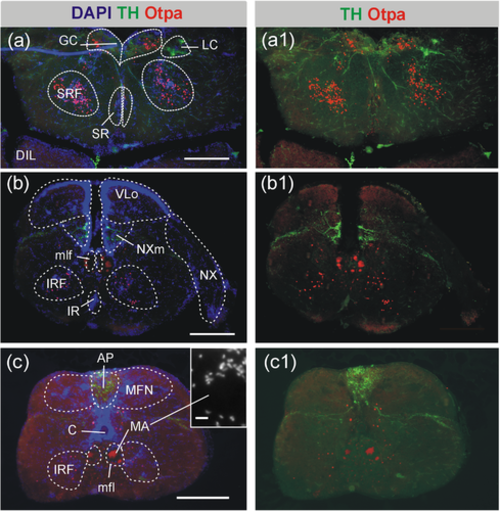Fig. 5
- ID
- ZDB-FIG-220801-247
- Publication
- Eugenin von Bernhardi et al., 2022 - A versatile transcription factor: Multiple roles of orthopedia a (otpa) beyond its restricted localization in dopaminergic systems of developing and adult zebrafish (Danio rerio) brains
- Other Figures
- All Figure Page
- Back to All Figure Page
|
Distribution of catecholaminergic (TH) and Otpa-positive cells in the adult zebrafish posterior hindbrain. Based on DAPI stains, epifluorescence microscopic analysis of transverse sections shows no cellular colocalization in the locus coeruleus (a/a1) and in the vagal catecholamine group (b/b1). In the area postrema, catecholaminergic (TH-positive) and Otpa-positive cells intermingle, but with no apparent double-labeled cells (c/c1). Otpa-positive cells are furthermore seen in the central gray, superior reticular formation, and superior raphe (very few, a/a1), as well as in the inferior reticular formation (b/b1-c/c1). Scale bars = 250 µm (a-c), 10 µm, inset in (c). Abbreviations: AP, area postrema; C, central canal; DIL, diffuse nucleus of hypothalamic inferior lobe; GC, central gray; IRF, inferior reticular formation; LC, locus coeruleus; MA, Mauthner axon; MFN, medial funicular nucleus; mlf, medial longitudinal fascicle; NX, vagal nerve; NXm, vagal motor nucleus; SR, superior raphe; SRF, superior reticular formation; VLo, vagal lobe |

